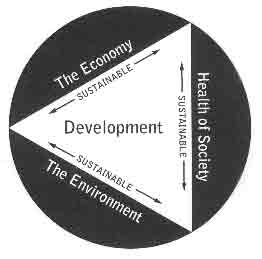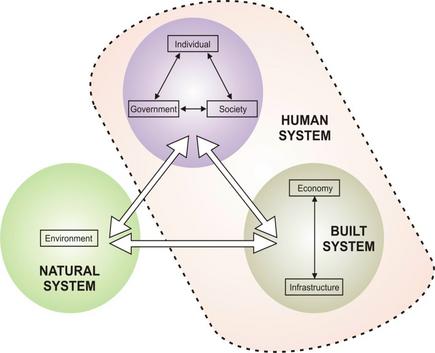Sustainable Development in Northeast
[TamilNet, Tuesday, 30 September 2003, 04:45 GMT]
International institutions and foreign governments have pledged funds, developed strategies, and formed committees in preparation for rehabilitating and reconstructing the war ravaged Northeast. But sustainable development holds the key to developing Northeast which is in need of infrastructure development, industrial development, agricultural and fisheries improvement, technological advancement, education and training and other areas.
Concerns about the environment and development are not new. More recently, the global dialogue has focussed on strategies needed to address the inter-related challenges of building healthy societies, economies and environments. This dialogue has its roots in the gradual merging of the environmental movement and the post Cold War international development community. Over the last decade, optimism about the creation of a modern technological utopia has been replaced by a more realistic understanding of the forces contributing to the world’s problems.
What is Sustainable development?

In 1987, the World Commission on Environment and Development, appointed three years earlier by the U.N General Assembly and headed by the former Norwegian Prime Minister Gro Harlem Brundtland, made sustainable development the theme of its report, "Our Common Future." The commission identified the concept simply as a form of development process that "meets the needs of the present without compromising the ability of generations to meet their own needs."
Sustainable development has three principal dimensions: economic growth, social equity and protection of the environment. Maximisation of social well being and poverty alleviation through the optimal and efficient utilisation of the natural resources is the economic dimension. The social aspects refer to the improving access to health and education services, fulfilling standards of security and respect for human rights. The issue of equity, i.e., the distribution of benefits and access to resources remains an essential component of both the economic and social dimensions of sustainable development. The environmental dimensions, on the other hand, are concerned with the conservation and enhancement of the physical and biological resource base and eco-systems.

| Dr Gro Harlem Brundtland, Norway's first woman prime minister, chaired starting in 1983, the World Commission on Environment and Development, which coined the concept of "sustainable development". In 1998 she became director-general of the World Health Organization. |
The challenge for the development planners and implementers in the Tamil homeland is operationalizing sustainable development whilst effectively managing the complex relationships between economic, social and environmental objectives. “Guidance for Preparing National Sustainable Development Strategies (NSDS)” developed by the UN provides a basic framework.
National Sustainable Development Strategy
A National Sustainable Development Strategy (NSDS) is a coordinated, participatory, iterative and cyclical process of thoughts and actions to achieve economic, environmental and social objectives in a balanced and integrated manner. The process encompasses situation analysis, formulation of policies and action plans, implementation, monitoring and regular review. NSDS is a cyclical and interactive process of planning, participation and action in which the emphasis is on managing progress towards sustainability goals rather than producing a plan as a product.
Northeast would benefit by determining, for itself, how best to exploit the NSDS preparation and implementation based on prevailing political, historical, cultural and ecological circumstances. NSDS will enable Northeast to institutionalise processes for consultation, negotiation, mediation and consensus building. The customised application of NSDS will empower the policy makers to address build capacities, develop procedures and legislative frameworks; allocate scarce resources rationally and present timetables for actions.
 Courtesy EOLSS (Encyclopaedia of Life Support Systems)Problems with traditional approach
Courtesy EOLSS (Encyclopaedia of Life Support Systems)Problems with traditional approach
Several countries in the past have developed national strategies for economic growth, improving social welfare, and safeguarding the environment. Some of these plans were developed based on national needs, whilst multilateral institutions such as IMF and World Bank sponsored others. Overall, these approaches had mixed results. There were notable achievements in some areas, but serious shortcomings existed too, which were common in many countries. These shortcomings include
- The lack of clear and pragmatic vision of development
- Absence or limited national ownership
- Too much focus on “document” production
- Inadequate or lack of public consultation in the identification of problems and setting priorities
- Lack of integration of the strategies into the overall development strategy
Principles of NSDS
Derived from the experience of the past NSDS is based on the following principles, which need to be tailored to suit the ground realities in the Northeast
- Backed by strong political commitment
- Based on shared strategic and pragmatic vision
- Nationally owned and country driven process
- Built on existing knowledge, expertise and capacity
- Built also on existing process and strategies
- Spearheaded by a strong institution
- Participatory and the “widest possible participation” to be ensured
- Anchored the strategy process is sound technical analysis.
- Integrated and balanced across sectors and territories
- Link the short to the medium and long term
- Coherence between budget and strategy priorities
- Set realistic but flexible targets
- Link national and local priorities and actions
- Build mechanisms for monitoring, follow up, evaluation and feedback
- Ensure continuity of the strategy development process
Operationalizing the NSDS Principles
Four critical processes are needed to continuously reinforce the above principles.
I. Political Process
Any strategy that does not have the full commitment of the leadership is bound to fail; NSDS is no exception.
II. Technical process
NSDS formulation involves, needs assessment, problem identification, prioritisation, developing investment programme, monitoring and evaluation. Northeast’s economic managers need to bring the best expertise from amongst both local and expatriates during the technical process.
III. Participatory process
Involvement of NGOs, community groups and the population at large will stimulate the NSDS. These groups should be involved at the strategy design, information gathering and implementation stages of NSDS.
IV. Resource Mobilisation process
once the above three processes are in place the donor community will have the confidence to part hard currency, which is vital for any development projects. Multilateral agencies such as the IMF and World Bank will do the promotion for Northeast to solicit much needed aid money, which may take the form of a grant or long-term loan with concessions.
Sustainable development the way forward
As Northeast goes through the reconstruction and rehabilitation programme, incorporating the principles of sustainable development will place the traditional Tamil homeland in an excellent platform for the future. A clear vision of a sustainable development and its execution will enable the nation to strike the right balance between exploiting the environment for development needs, whilst advancing the social and economic aspects of the society.
Related Articles:15.09.03
LTTE's polythene ban in Vanni earns plaudits 22.07.03
NE local government week celebration concluded 01.03.03
Impact and Issues of Forestry on Northeast Coastal Resources 14.01.03
Apathy spells bleak future for Jaffna coconut 16.11.02
Protecting Northeastern Coastal Resources
External Links:







 In 1987, the World Commission on Environment and Development, appointed three years earlier by the U.N General Assembly and headed by the former Norwegian Prime Minister Gro Harlem Brundtland, made sustainable development the theme of its report, "Our Common Future." The commission identified the concept simply as a form of development process that "meets the needs of the present without compromising the ability of generations to meet their own needs."
In 1987, the World Commission on Environment and Development, appointed three years earlier by the U.N General Assembly and headed by the former Norwegian Prime Minister Gro Harlem Brundtland, made sustainable development the theme of its report, "Our Common Future." The commission identified the concept simply as a form of development process that "meets the needs of the present without compromising the ability of generations to meet their own needs." 
